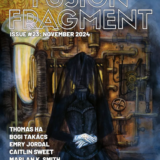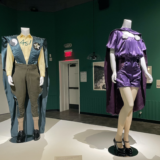
Well, it’s been a long, hot summer already, hasn’t it? I don’t know where you all live, but here in Vancouver, BC, we’ve had some days of record-breaking heat. I read in today’s paper that Death Valley has had a couple of days of the highest temperature ever recorded on this planet (130.0 degrees Fahrenheit, or 54.4°C). Sounds pretty hot to me! In an effort to cool down, I’ve stayed out of my office a lot recently, which means I’ve not done a column for a while. So today you get reviews of two “Golden Oldies,” thanks to Graeme Cameron, fellow Amazing Stories® Online columnist, who gives me ideas of old b/w movies to watch. This week’s movies are both from 1958: The Vampire, and I Bury the Living (with Richard Boone, of all people).
The ‘50s, what a time (for the white middle class, that is). Not that my family was middle class—my dad was in the US Air Force—we were probably lower-middle. Certainly didn’t have buckets of money. I seldom got a chance to see these movies in the theatre; when our family went to the movies, it was usually a drive-in. Movies I can remember seeing at a drive-in: Fantasia, Wizard of Oz (before it became a TV standard), The Sundowners (well, that was 1960), The Hanging Tree, etc. I got to go to some matinees on the air base in Panama City, Florida (Tyndall AFB) for either a quarter or 50 cents. Those were the times I could see genre movies. (Remember Matinee, with John Goodman? That was us in Florida during the Cuban Missile Crisis.) It was in the late ‘50s, early ‘60s I got to see these kinds of things on TV, when the demand for old genre movies was high—they had all these TV channels (up to three or four in some places), and they had to fill all those late-night spots. Today’s kids might not believe it, but up until the middle ‘60s, we had only one TV channel, wherever we were—Duluth, MN; Yuma, AZ, Panama City, FL—and that went off the air usually before midnight. To paraphrase William Gibson, “the TV was an empty channle the colour of the sky.”
One of the movies I never saw—and that partially because my mother was firmly convinced that all this SF/F and monster stuff would almost literally rot my brain (it’s a cliché, but she really did throw away all my EC comics, thanks to Dr. Fredric Wertham). Guess what, mom? You were right—my brain is rotted, and I couldn’t be happier about it!—was The Vampire (1958), starring John Beal, Coleen Gray, and Kenneth Tobey. (Other actors I recognized were Dabbs Greer, James Griffith, and Paul Brinegar, who played Mayor Jim Kelly in Wyatt Earp. Griffith had been in practically every Western on TV, and likewise Greer. Tobey, of course, is familiar to every SF fan of ‘50s movies.)

The movie itself is a bit of fluff, mainly notable for Beal, who turned in a tortured performance worthy of Lon Chaney Jr.’s Larry Talbot. The story in a nutshell is that Beal is Dr. Paul Beecher, a small-town doctor—the kind of doctor who tells his poorer patients not to worry about paying him until they can afford a payment. Dr. Beecher has a young daughter Betsy (Lydia Reed), who sometimes acts as his receptionist. There’s another doctor (Dabbs Greer), Dr. Beaumont, who’s researching something that involves making pills out of vampire bat blood, and who dies. Gray plays Beecher’s new nurse and possible love interest, Carol Butler. Dr. Beecher accidentally takes two of these tablets, thinking they’re aspirin, and turns into a monster that craves blood (human blood, bwah-ha-ha-haa!). When he bites his victims, some viral component in his blood destroys all their flesh, veins, arteries, and so on (Figure 3).

Tobey plays a cop who’s trying to figure out how these people died, which is unusual, as he usually plays a military guy (The Thing From Another World, The Beast From 20,000 Fathoms, It Came From Beneath the Sea) in genre movies, although on TV he was in every type of show.

Eventually, Dr. Beecher figures out that every time he takes the pills, someone dies; puts that together with a lab report that the pills are a vampire blood potion, and begs to be killed (as said before, à la Lon Chaney, Jr.) But nobody believes he’s the vampire (as you can see from Figure 4, this isn’t your Bela Lugosi suave vampire type), so he eventually changes in broad daylight and attacks someone. He’s shot and reverts in death to the tortured Dr. Beecher (thus totally spoiling the whole “love interest” thing, btw). It’s all a bit slow for a genre movie, but overall quite worth watching, in my opinion.

I don’t know if you’ve noticed, but one thing I seem to have been mentioning a lot here is ‘50s Westerns (TV shows). One reason I notice a lot of actors in those Westerns is that our Co-op’s satellite has Starz Westerns as a station. I’ve been watching several of the old b/w ‘50s ones, like The Life and Legend of Wyatt Earp; Cheyenne; Maverick; Laramie; Death Valley Days; Have Gun, Will Travel; and so on (one reason I know many of the actors mentioned above). Westerns were very important in the ‘50s. As I said, there was a lot of TV time to be filled in the evening, and Westerns were good prime time fare. Besides, in today’s fast-paced, complex world, there’s something to be said for the simplicity of most of those shows, where the good people and the bad people were often easily told apart, and the whole storyline could be wrapped up in thirty to fifty minutes. Sure, there was a lot of violence, but often as not, it was fairly bloodless violence. And racism, colonialism, and all the other isms you can think of that the fifties were famous for. (As a matter of fact, with all the usual TV pre-show warnings we see these days, Starz has added “outdated cultural references” to them.)
But not all were totally simplistic; some had some fairly sophisticated writing crammed into a half-hour show—such a show was Have Gun, Will Travel, starring Richard Boone as “Paladin,” an old West mercenary who, in his off-hours, lived in a posh hotel in San Francisco, and roamed the Old West dispensing Shakespeare and justice in equal amounts. Paladin always fought on the side of right insofar as he could discern it, and Boone was by turns courtly, manly, and as brutal as circumstances demanded. Plus, his gravelly voice was emphatic (more so than John Dehner’s—Dehner played Paladin in the radio version that was an offshoot of the TV show) and commanding. Scripts were written by such people as Gene Roddenberry and Sterling Silliphant, and many actors who rose to A-list prominence in the sixties were guest stars on this show. It was so good a show that Boone became identified with Paladin, much as George Reeves would become identified with his Superman character, although Boone never seemed to mind that and, in fact, made a lot of Westerns. He wasn’t limited to one character, as Reeves felt he was, and played the voice of Smaug the dragon in Rankin-Bass’s animated The Hobbit, years later; his voice, by now extremely gravelly and emphatic, was to my mind much better than Benedict Cumberbatch’s later Smaug.

So in this movie he plays Robert Kraft, who’s become the director of a cemetery. There’s a caretaker, Scotsman Andy McKee (Theodore Bikel, also known as a folksinger) who’s been with the cemetery forty years; and a love interest, Anne Craig (Peggy Maurer), but she doesn’t really figure into this in any significant way (IMO). Kraft is succeeding his father, George (Howard Smith), some sort of “noblesse oblige” thing the upper crust are into. There’s a large map of the entire cemetery, with each plot marked with a white or black pin. The white pins are for assigned plots that haven’t been used yet (empty yet purchased plots), and the black are for people who are filling their assigned spots (some TV show I saw in the last couple of days was talking about euphemisms for being buried: “six feet under,” “eating a dirt sandwich,” “taking a dirt nap,” and so on. Can’t remember where I heard that.)

Robert has a good friend, Stu Drexel (Glen Vernon), who has an open sportscar, and who just got married; they have just got a plot in the cemetery. Robert grabs a pin, not noticing its colour, and sticks it in the map. (Spoiler… it’s a black pin.) Before Stu and his new bride drive up, Kraft tells Andy that he’s going to be retired, but thanks to his forty years’ service, he’ll get a full pension. “Ye mean I’m ta be paid forr doin’ nothin’?” Andy says. “No, you’ll be paid for forty years of loyal service,” Robert tells him. Then Andy shows him where the cemetery pistol is stored in case of emergency, just before Stu drives up. Shortly after, as Robert is being formally inducted as chairman of the cemetary, he receives a call from the undertaker that his friend Stu and his wife have died in a car crash. Robert finds out from Andy that he put black pins in.
A couple of deaths happen after Robert puts black pins in the map instead of white, and Robert starts believing that he is causing death by changing white pins to black. A few tests later he is absolutely convinced of it. And here I’ll rest the description because there is a twist in this movie. (Hey, the supernatural ain’t what it used to be.)
The movie uses only a few sets, and those are fairly cheaply made; Boone does his usual competent job, and the other actors do theirs, although only his friend the newspaper guy Jessup (Herbert Anderson) is really convincing. The main stumbling block here is Theodore Bikel; in spite of the fact that he speaks several languages (IRL) and is good at dialects, his Scotsman is very unconvincing. His makeup isn’t that good, either. Too bad; I’ve always liked Bikel (especially as Meyer in the Rod Taylor Travis McGee film Darker Than Amber) both as actor and folksinger. Partially because of his performance, this film isn’t as good as it could have been. But it’s still watchable.
Have anything to say about my column? Flowers, brickbats, more information? You can comment here or on Facebook—or even by email (it’s stevefah at hotmail dot com). I’d love to hear from you! My opinion is, as always, my own, and doesn’t necessarily reflect the views of Amazing Stories or its owner, editor, publisher or other columnists. See you next time!










